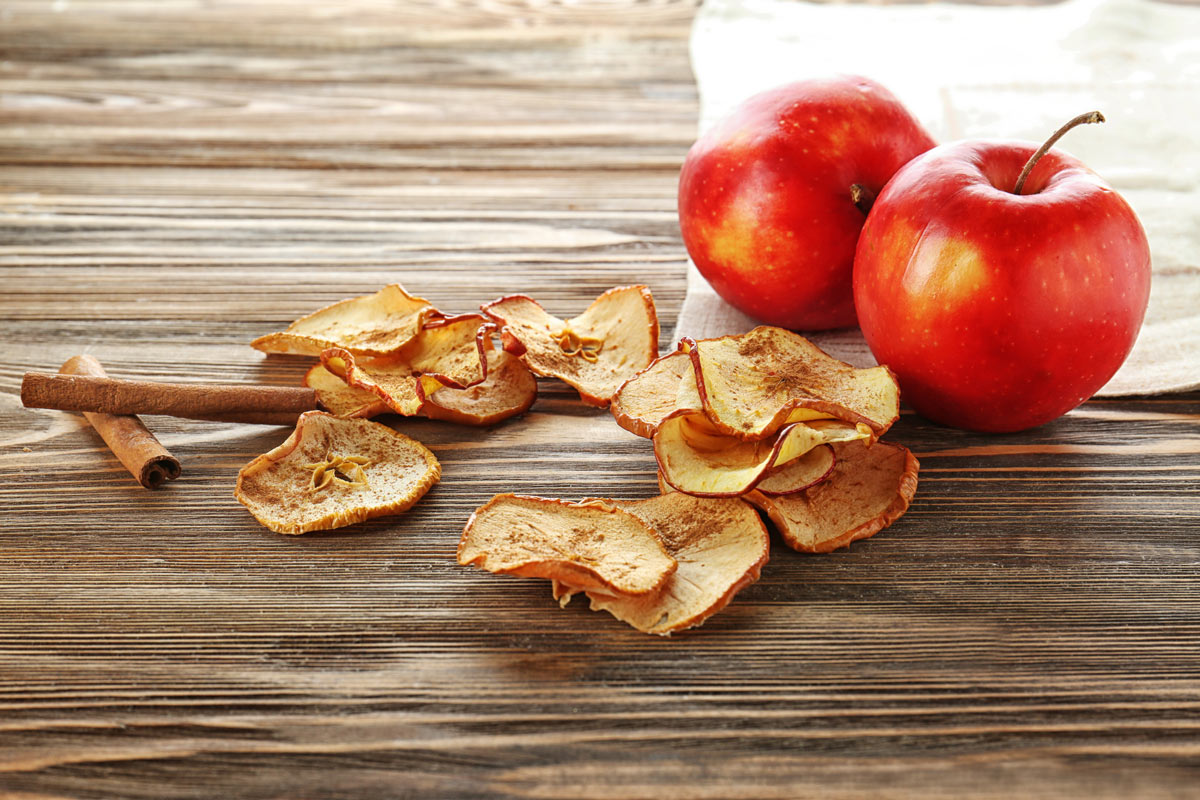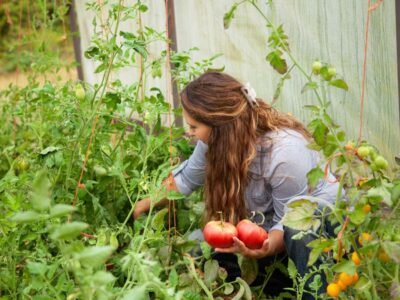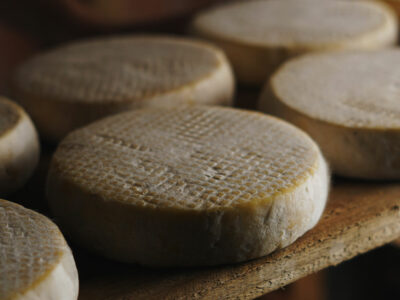What exactly are the differences between freeze-drying vs. dehydrating. Are there benefits that outweigh one from the other? Are there certain foods that should or shouldn't be preserved by these methods? All this and more are below!
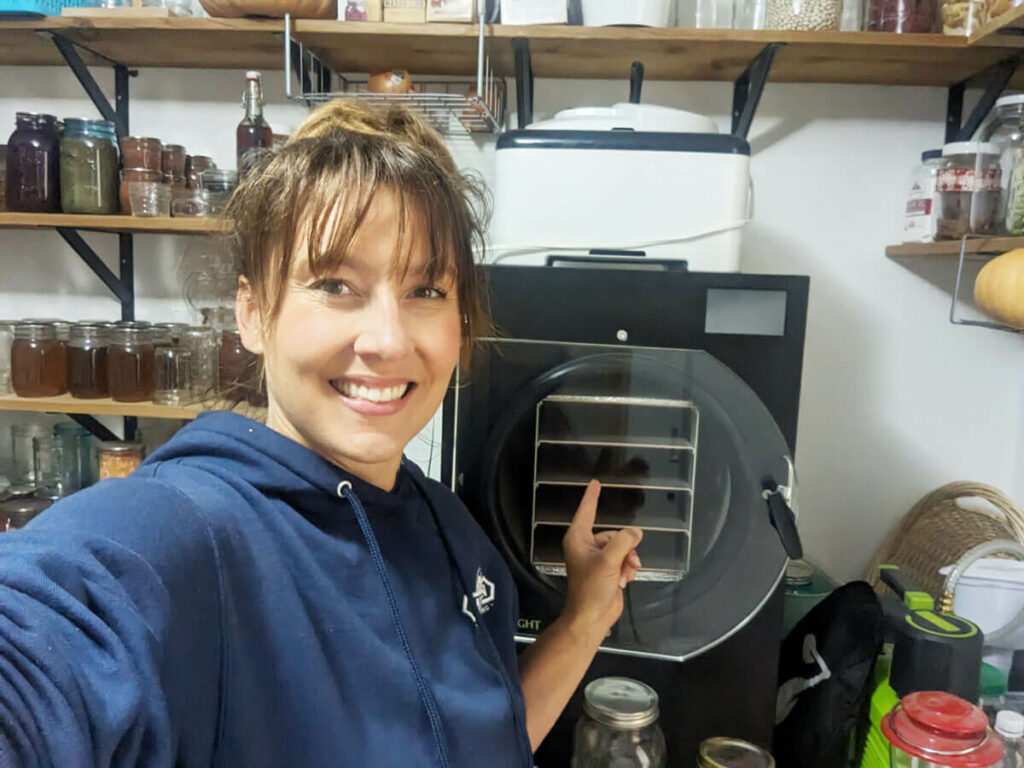
There are many ways to preserve food at home and I've discussed easy & fast preservation methods, as well as the best ways to preserve eggs, meat and dairy. But in today's post and Pioneering Today Podcast (episode #395) I'm discussing the differences between freeze-drying and dehydrating different foods.
What's the difference between these two methods of food preservation, which is better, are there certain foods that aren't suited to these methods, and what are the benefits of each method.
Be sure to check out our other episodes of the Pioneering Today Podcast here.
What is Freeze Drying?
Freeze-drying is a relatively new way to preserve food at home with a home freeze-dryer. Commercially freeze-dried food has been available for decades, but home freeze dryers have really picked up in popularity in the last ten years.
A freeze dryer is a two-step process of preserving food. It first takes food and freezes it into negative temperatures (about -40°F). At that point, the water content within the food is vapor.
Then, a pump kicks on and sucks the vapor and all the moisture out while simultaneously dehydrating the food.
The end product is a very different product from dehydrated food. So when it comes to freeze-drying vs. dehydrating, there are many differences. But that doesn't always mean it's better!
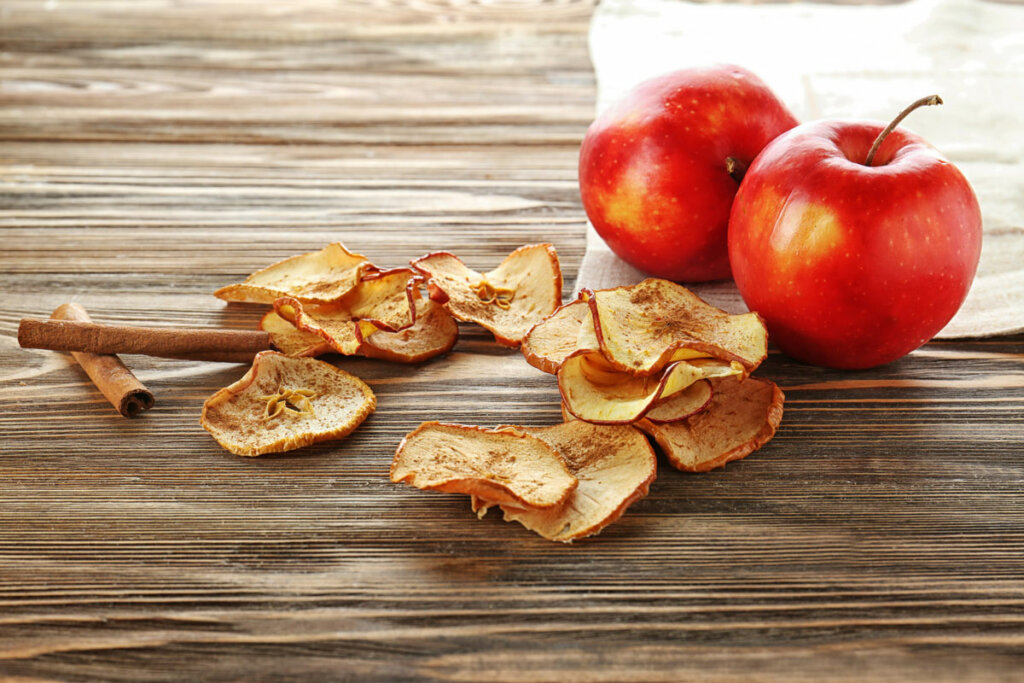
What is Dehydrating Food?
Dehydrating food is simply removing all the moisture content out of foods over a long period of time using elevated temperatures and airflow. Food can be dehydrated at various temperatures, but it's important to know what temperatures are necessary for specific foods to stay safe.
Dehydrating Temperatures
While most herbs can be dehydrated safely at room temperature, you wouldn't want to dehydrate meat at room temperature. Here are some basic temperatures for dehydrating various foods.
- Meat – 160°F
- Fruit – 125°F
- Vegetables – 135°F
- Herbs or Raw Foods – 95°F
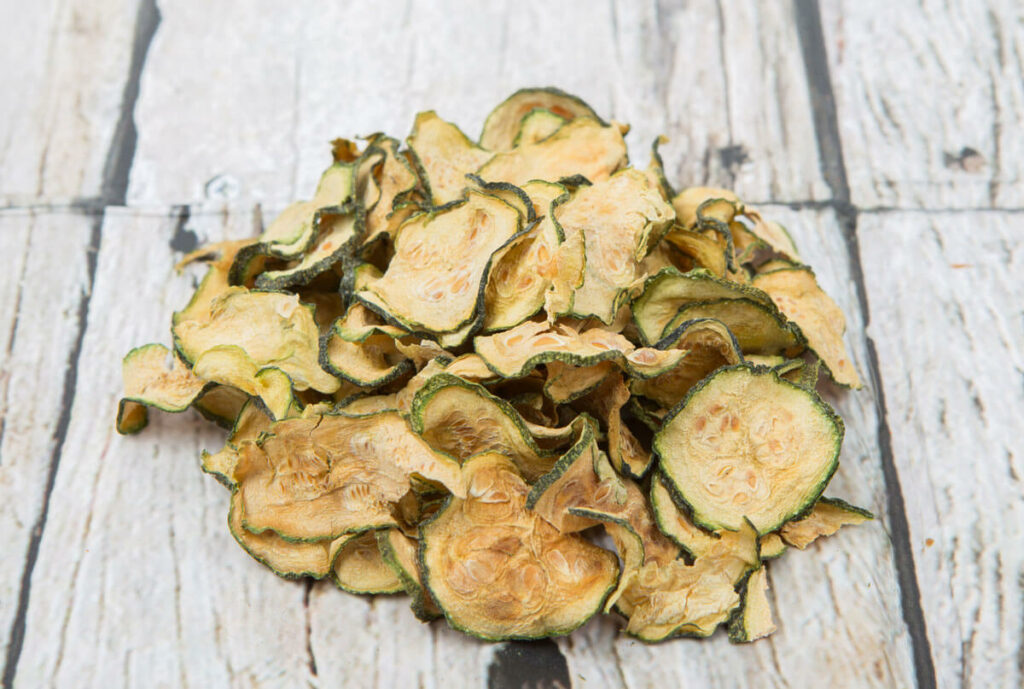
Difference in Texture
Freeze-dried food will have a much different texture than dehydrated food. While many dehydrated foods get leathery, crispy or even chewy, freeze-dried food tends to be more brittle, crunchy and some foods could even be considered airy.
A dehydrated strawberry will end up as a chewy, almost leathery snack, while a freeze-dried strawberry will be crunchy and airy in texture. The dehydrated strawberry will shrink in size while the freeze-dried strawberry will maintain its same shape and size.

Foods That Can Be Dehydrated
Some foods can be successfully dehydrated and freeze-dried, so it will come down to a matter of preference. But there are definitely some foods that are better off when dehydrated.
- Cooked Meat (Jerky)
- Raw Vegetables
- Raw Fruit
- Cooked Eggs
The drawback to some of these dehydrated foods is that the texture, once reconstituted, isn't like the fresh version. Many freeze-dried foods maintain the same texture once reconstituted (I really notice this with dehydrated vs freeze-dried vegetables).
Foods That Cannot Be Dehydrated
- Raw Meat
- Raw Eggs
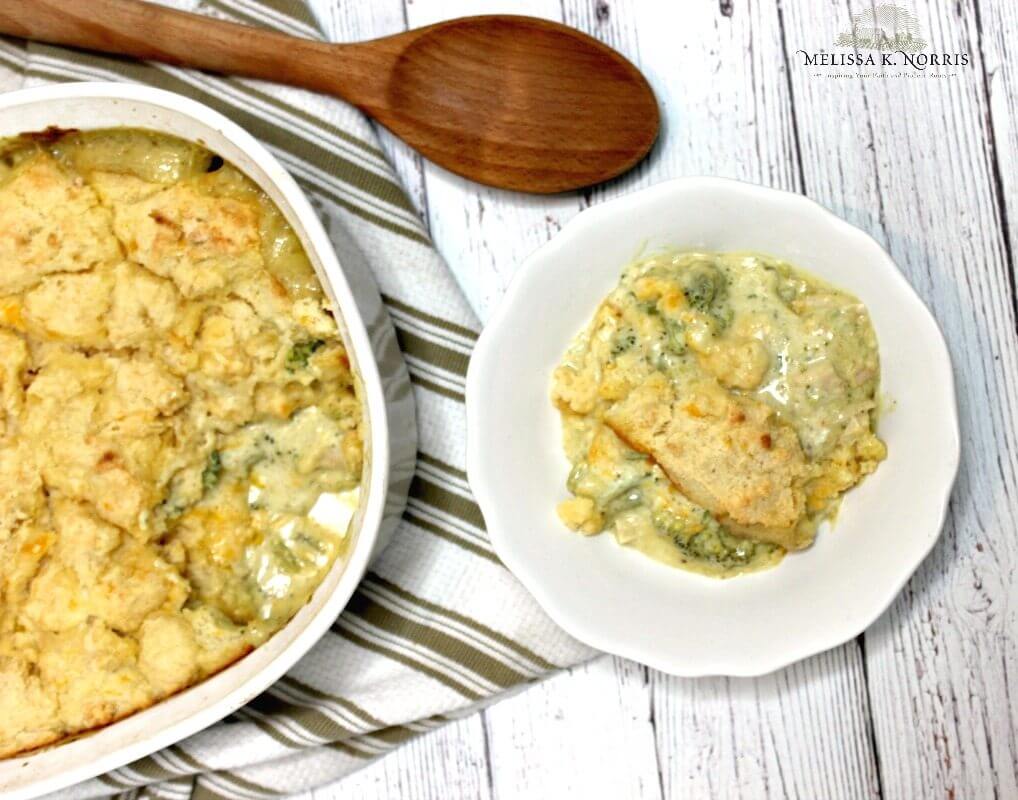
Foods That Can Be Freeze-Dried
As I mentioned, some foods are a matter of preference when it comes to dehydrating or freeze-drying. However, some foods simply cannot be safely dehydrated and must be freeze-dried (or preserved another way).
One of the main differences with freeze-dried foods is that those foods that must be cooked to be safely dehydrated can be freeze-dried in their raw state. After rehydrating those foods, they must be cooked to be considered safe to consume.
Foods That Can Be Freeze-Dried
- Raw & Cooked Meat
- Raw & Cooked Eggs
- Raw & Cooked Veggies
- Raw & Cooked Fruit
- Milk/Ice Cream
- Coffee/Hot Chocolate (check out my freeze-dried hot chocolate recipe here)
- Candy (only certain kinds)
- Leftovers
- Soups/Stews
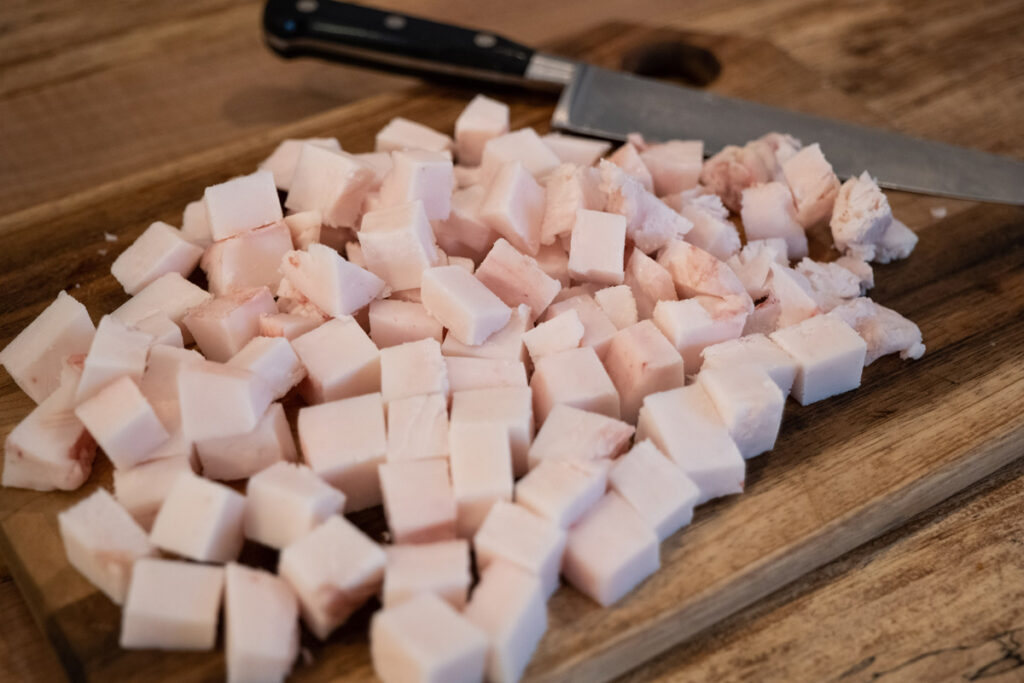
Foods That Should Not Be Freeze-Dried
There are certain foods that should not be freeze-dried. These are items that have a higher fat content such as bacon, fatty meats, butter, etc.
The fat in these foods is very dense and doesn't freeze dry well. That doesn't mean it can't be done, however, the shelf-life of these products will be much shorter.
In my opinion, most of the fattier foods are better off frozen for long-term storage.
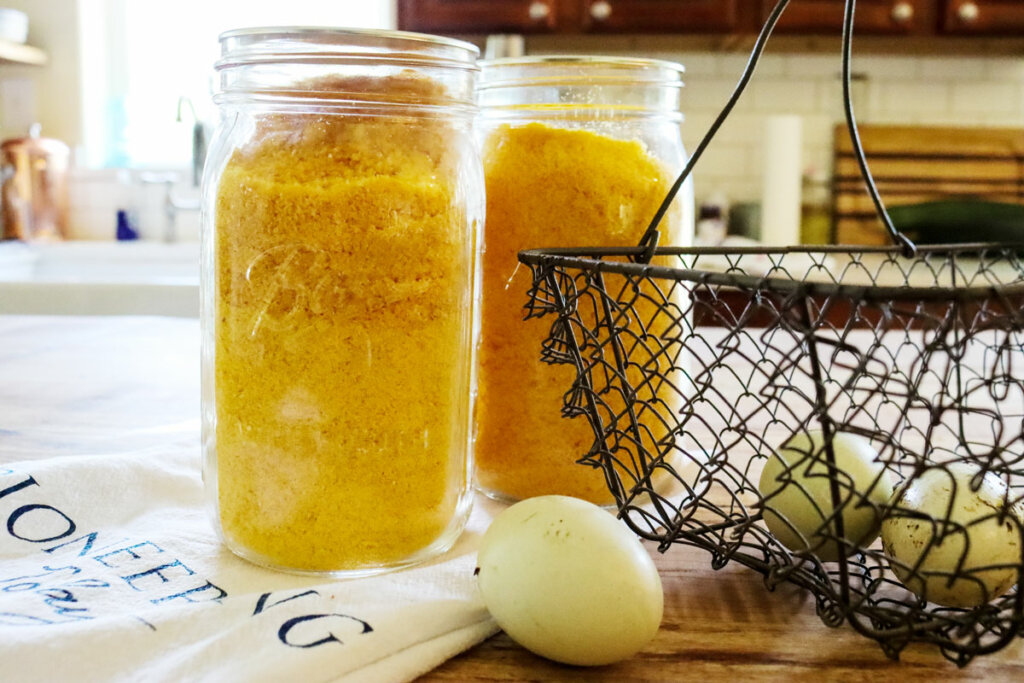
Storing Freeze-Dried and Dehydrated Foods
When it comes to storing freeze-dried and dehydrated foods, the method is very similar. You want to store them in air-tight containers where they don't have exposure to oxygen or moisture.
Any exposure to air will reintroduce moisture and can cause the texture to change or even cause spoilage.
My go-to method for storing freeze-dried and dehydrated foods is in a canning jar with a lid. I then use a vacuum sealer to seal the jar, and I store them with the ring on. (This is the opposite of what's recommended for canned foods, as you don't want to store canned food with the rings on.)
Pro Tip: If it's a food that I want to last on the shelf for more than six months, I'll add an oxygen absorber. But if I'm going to consume it within six months, I don't bother adding one.

Azure Standard
Today's sponsor of the podcast is Azure Standard, and that's actually where I get all of my oxygen absorbers and mylar storage bags. If you're new to Azure Standard, they're offering 10% off your first order of $50 dollars or more. Simply use coupon code “Melissa10” to get 10% off your order.
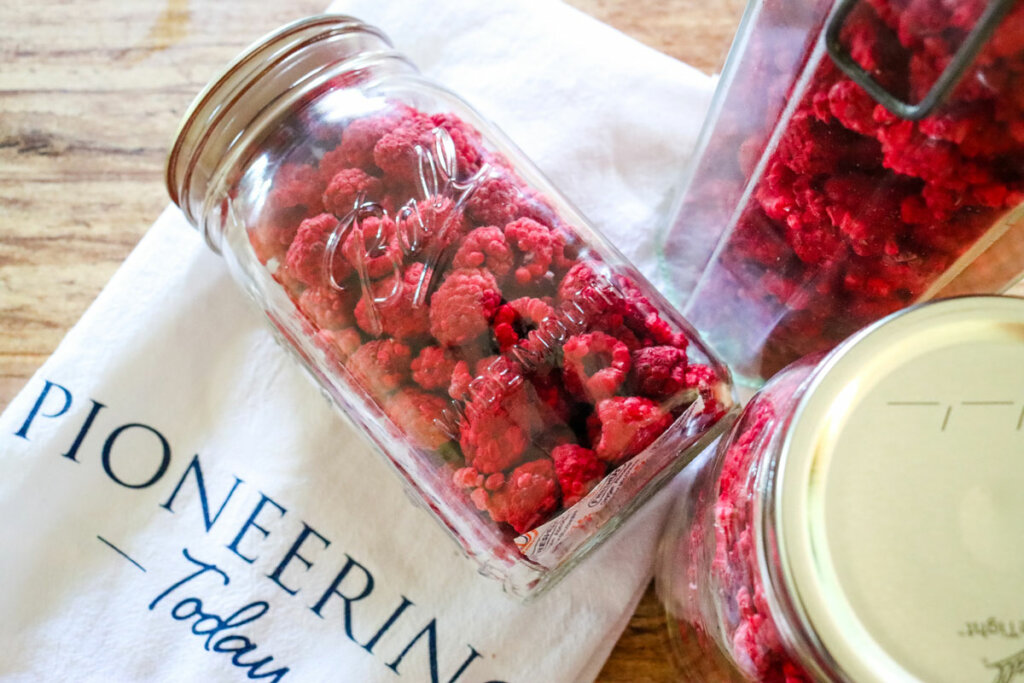
Benefits of Freeze-Drying
Health
Of all the forms of food preservation, freeze-dried foods retain the most nutrients when compared to fresh (even above dehydrated).
You do want to make sure to adjust the dehydrating temperature when freeze-drying foods to maintain their raw state (like medicinal herbs), but the beauty is you can do this by adjusting the settings.
Versatility
One of the main benefits of freeze-drying is the versatility of what can be freeze-dried. I love using my freeze-dryer for leftovers.
For example, if I make a large lasagna and my family only eats half of it, I can divide it up into serving portions and dehydrate it. Then I have shelf-stable lasagna that can be reconstituted and eaten anytime in the next 25 years!
And the end product is versatile. I can add freeze dried zucchini to soups, stir-fries, baked goods, or even make zucchini flour out of it.
Taste
One of the things I have noticed personally with dehydrated vs. freeze-dried foods is when it comes to fruit. Dehydrated fruit tends to get much more concentrated in flavor and sweetness. Freeze-dried fruit tends to taste exactly like the fruit when it's fresh.
So for me, I generally prefer to freeze-dry all our fruit, with the exception of my very favorite dehydrated cherries!
Ease
With a freeze-dryer, you can add the trays to the freeze-dryer, hit a few buttons and walk away. The freeze-dryer will hold the food at a certain temperature until you're able to check it to ensure it's completely freeze-dried.
A dehydrator, however, needs to be checked frequently, you risk over-dehydrating smaller pieces of food before the larger pieces are completely dry, and you usually have to shift trays around to get things to dry evenly.
Foods
There are certain foods that can only be freeze-dried and still be shelf-stable at room temperature.
Items such as mashed potatoes or pureed pumpkins aren't safe for water bath canning, pressure canning or dehydrating. Other than freeze-drying, there is no safe method of preservation for these foods where they are shelf-stable. Yes, they can be frozen, but that takes precious freezer space, and it isn't shelf-stable.
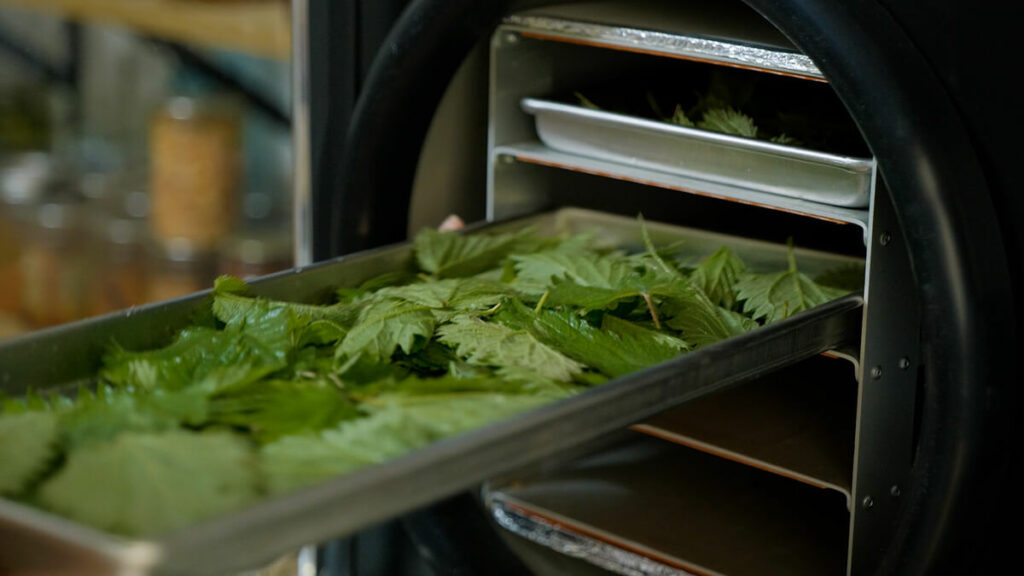
Disadvantages of Freeze-Drying
Cost
The main disadvantage when it comes to freeze-drying that I hear often is the cost. The freeze-drying machines are expensive (starting at just over $2,000 at the time of this publication), making them unobtainable for many.
I get asked frequently if a freeze-dryer is worth the cost, and my answer is always it is, if you'll use it! If it sits on the shelf and doesn't get used, however, I'd say your money is better spent elsewhere on the homestead.
Heavy & Space
A freeze-dryer is a large unit and too heavy for one person to move. Therefore it needs a solid surface where it will stay. It also needs to be run on a dedicated 220 line.
The freeze-dryer also must be elevated so the drain can function properly.
Noise
A freeze-dryer is much louder than I thought it would be. It's not like the gentle hum of a dehydrator. Though it's not quite as loud as a vacuum cleaner, it's on the same level as that, in my opinion.
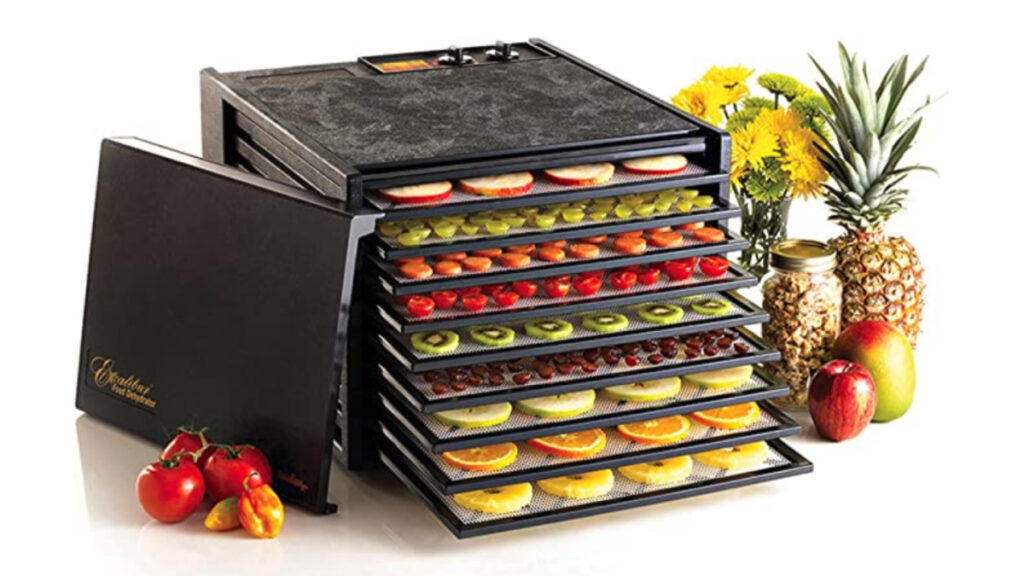
Benefits of Dehydrating
Space
One of the benefits of dehydrating foods is that the finished product takes up much less space than the fresh food did.
This isn't the case with freeze-dried foods. They take up the same amount of space. So if I freeze-dry half a gallon of milk, I'm going to need that same half-gallon container to store the freeze-dried milk in.
Likewise, a quart of freeze-dried raw eggs will be stored in a quart-sized jar.
Time
One of my biggest surprises when I got my freeze-dryer, was the amount of time different foods take to be freeze-dried. I thought many foods would be much faster than they are.
Herbs, for example, can be dehydrated much faster than they can be freeze-dried.
Though most foods take approximately the same amount of time for freeze-drying as they do for dehydrating, there are some exceptions.
Food Specific Items
There are certain foods that are only made through dehydration. I'm talking about homemade fruit leather and homemade jerky! There are simply no freeze-dried options!
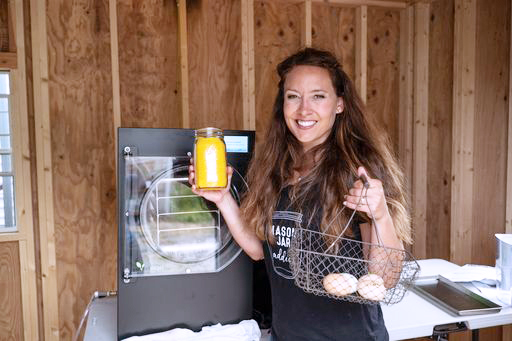
Harvest Right
The freeze-dryer that I have is a Harvest Right and I have the medium size. At the time of this publication, they're having one of their largest sales of the year where you can get $500 off a machine through the end of June 2023! That's nearly 25% off.
If you've been wanting a freeze-dryer, now is a great time to get one!
Verse of the Week: John 21:20-22
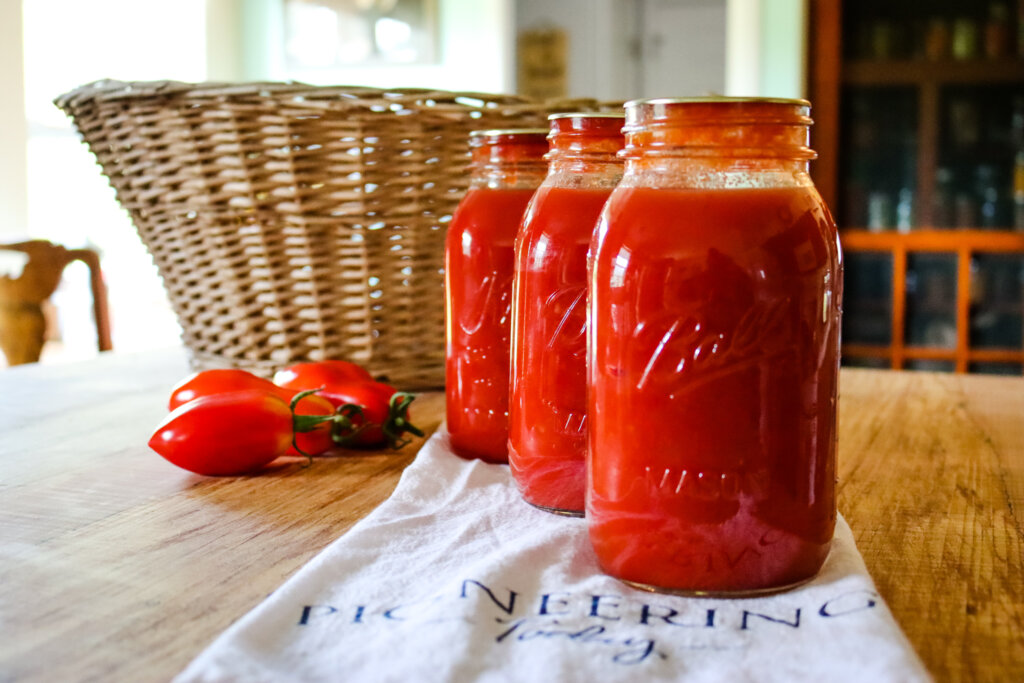
More Articles on Home Food Preservation
- Must-Know Freeze Drying Tips (With Carolyn Thomas)
- The Science of Home Food Preservation
- Tips for Home Food Preservation – Seasonal Preserving Each Month
- A Complete Guide to Home Food Preservation (What to do When You Can’t Find Canning Supplies)
- 9 Ways to Preserve Food at Home
- How to Store Home Canned Food Safely – Jar Stacking & Canning Rings
- How to Pick the Best Preserving Methods
Hey, Pioneers! Welcome to episode number 395. Today's episode we are going to be talking about freeze drying versus dehydrating, pros and cons of each of those.
As you know, home food preservation is one of my absolute favorite topics, and this question came in actually from one of the members inside our membership, the Pioneering Today Academy, when we were doing one of our live calls, and I thought it would make an excellent podcast episode to talk with all of you about.
So first up, let's talk about what is freeze drying. So freeze drying is a relatively new way to be able to preserve food at home with a home freeze dryer. Commercially, food has been able to become freeze-dried for a long time. Well, decades at least. But home freeze dryers really just came on the market within the last decade or so and have really started to gain popularity in about the last five years.
So how does freeze drying actually work? How is it different than dehydrating? Well, a freeze dryer is a two-step process before the food is finished in its preserved form. So a freeze dryer first takes food and freezes it. And it actually takes it down into the negative temperatures, about negative 40 degrees Fahrenheit. When it gets that cold, the moisture that's in the food then becomes vapor. And at that point you have a pump that kicks on and it actually sucks the moisture, which is in a vaporized format at this point out of the chamber. And then it switches over and it actually dehydrates the food. So it is a form of dehydration. There is a process within the freeze drying, the drying part that is dehydrating, but you end up with foods that are very different end product wise from using a regular dehydrator and comparison to freeze-dried food.
So both of them are removing moisture from the food, and that is the way that it actually is preserving it by taking away the moisture. Once you've hit certain percentage of having the moisture gone from a food, then it doesn't break down as far as your molds, right? That's how the food stays shelf-stable. It doesn't have the moisture that's in it. So the freeze dryer will take the moisture out first by freezing it and then it dehydrates to finish the process. So freeze-dried food is different than dehydrated food, especially in texture.
So a dehydrator is simply going to pull out the moisturizer using airflow. There's a fan on most dehydrators, as well as some of your temperature changes. So with a dehydrator, you are able to select the temperature. Usually you're going to do things like meat around 160 degrees Fahrenheit when you have a regular dehydrator. Vegetables, you're going to do usually around 135. Fruits, about 125 degrees. And then your herbs or anything that you want to keep in a raw format is done at a much lower temperature, about 95 degrees Fahrenheit. But it is still using just air and temperature. There's no freezing component. So that's really the two differences between the two.
So freeze-dried food retains a very... It's very crunchy. Whereas it's dehydrated food, some foods you will get to that crunchy point, but a lot of them, think about raisins, right? That is a dehydrated grape. It still is in its chewy format. Well, anytime that you have freeze-dried food, if you've had freeze-dried apples, more people have had experience eating freeze-dried fruit because you can purchase freeze-dried fruit as snacks. And compared to dehydrated where it's usually more chewy, fruit is more of a chewy. If you've ever done banana chips dehydrated, they're kind of crunchy when you first get them, but after they've been pulled out of the dehydrator, they're usually more on the chewy side, where freeze-dried bananas and fruit still retain their crunch months or even years down the road, provided you have properly packaged them so that they are not having any air introduced to them while they're sitting on the shelf in whatever way you have packaged them. They will stay very crunchy.
So foods that are better dehydrated versus foods that are better freeze-dried. Some of it comes down to textural preference and just your personal tastes, and some of it does come down to safety. So let's address those two things. With dehydrating foods, you can safely dehydrate raw vegetables and raw fruit. However, it's not recommended to dehydrate raw meat or raw eggs. So you can dehydrate cooked eggs and you can dehydrate cooked meat. Think when we're making things like beef jerky, et cetera like that, you're dehydrating them, but the meat is at a cooked point. Same thing when we are talking about doing scrambled eggs. Most of the time people will do scrambled eggs and then they will dehydrate those to use in backpack meals or just to have in their food storage.
But the great thing about the freeze dryer... And the reason for that is because dehydrating food, say dehydrating and freeze drying does not eliminate... Just like when you put food in the freezer, right? If you put a raw steak in the freezer, it protects it while it's frozen, but you still have to cook that. So with dehydrated foods, that needs to be cooked before you dehydrate it so that you don't have the risk of things like salmonella or E. coli.
Now, freeze-dried, you can actually freeze-dried those foods raw and they will be fine, but of course you are going to rehydrate and then cook those foods. You wouldn't eat anything raw in a freeze-dried format that you wouldn't eat raw in any other format. So for raw steak, most people aren't going to eat raw steak or raw hamburger meat, et cetera. So still you need to cook things, but you can freeze-dry them raw and then you're going to cook them at reconstitution time. Whereas with dehydrating, you should not dehydrate raw eggs and then later go ahead and reconstitute and cook them, that type of a thing.
So you do have the availability with the freeze dryer to preserve more items than you can with the dehydrator. But where it really opens up with the freeze dryer is you can then freeze dry a lot of things that would just never dehydrate well, and that is leftovers. So you can do things like lasagna, like actual pieces of lasagna. You can do pop pie fillings. Of course you can do soups, you can do stews and chilies. You can do cheesecake bites. You can do ice cream. Almost anything can be freeze-dried. The exception to this is honey cannot be freeze-dried. It doesn't freeze dry well, nor does butter. So solid things of fat. Now you can have something like a pie crust that would were to have fat in it. And of course ice cream has fat in it, so you can do that. But you can't just freeze dry a stick of butter. It will not freeze dry right or turn out.
And the higher the fat content that you have in something, then it does shorten the shelf life of it once it's freeze-dried. So for example, fruits and vegetables, once freeze-dried, those have a shelf life of up to 25 years. A very, very long shelf life. The longest shelf life in comparison to hydrated foods. They don't generally have a 25-year shelf life. But if you have freeze-dried something that has a higher fat content in it, it's likely not going to last for 25 years on the shelf because the higher the fat content, even in a freeze-dried format, it has a higher likelihood of going rancid because of the fat and the oils in it. So kind of keep that in mind. But you're not going to be able to freeze dry ice cream bites or cheesecake and those types of things with a dehydrator like you can with a freeze dryer.
So the freeze dryer gives you a greater range of items that you can freeze dry. I freeze dry raw milk when we had our dairy cow, freeze-dried coffee so you can make your own espressos and lattes and then freeze dry that so that you can take it with you. There's a hot chocolate. I freeze-dry our hot chocolate. I make a big old huge pot of homemade hot chocolate and then we'll freeze dry that so we have our own instant hot chocolate.
I love freeze-dried potatoes. I will make mashed potatoes, withhold the butter and the milk. So basically you're boiling potatoes, straining that, adding just enough water in there to mash those up and then put them on the freeze-dried trays and freeze dry them. Once they're freeze-dried, then I put them through a food processor so they're blended up into really fine and then use them just like you would store about instant mashed potatoes. So at the time of cooking, I'm going to add my hot water to the measured out freeze-dried potatoes, and then I will add my butter and my milk when I'm making those instant potatoes into homemade mashed potatoes at the time of eating.
You can dehydrate cooked potatoes, but they don't generally reconstitute to the same level with freeze-dried. And I have to say personally, food preference wise, taste textural-wise, the freeze dryer has one hands down for me in comparison to the dehydrator because with a lot of dehydrated foods, if you are looking to rehydrate and cook with them, very rarely do they fully rehydrate back to the original texture. So if you have ever dehydrated things like carrots or broccoli, those types of things, you will rehydrate them with water and then generally cook them.
Now, if I'm cooking them in a soup or a stew or something that has a really long simmer time, they usually do okay. But if you are looking to just rehydrate dehydrated broccoli and then throw it in with roasted broccoli or roasted vegetables and stuff, to me that texture, it's always a little bit chewy, I guess, for lack of a better word. I don't feel like dehydrated vegetables in particular that have been rehydrated back ever really get, even if you cook them at that point, to the same texture. And I generally don't enjoy the texture to be honest of dehydrated vegetables that I am then cooking with later, except in like I said, something that's simmering for a very long time like a soup or a stew.
Now for things that you're just eating in that dehydrated or freeze-dried state, so dehydrated banana chips as example or grapes, et cetera, that I feel is a little bit more just your personal preference. Most of the time I prefer freeze-dried. I don't really like the chewiness of a dehydrated apple for example, but I love eating a crisp freeze-dried apple slice. So I no longer dehydrate any of our fruit. I freeze dry all of it with the exception of cherries. I love dehydrated cherries.
I dehydrate a whole bunch of cherries. You know how you have that mom cupboard, I'm talking to the moms out there, where you stash the really good chocolate? For me, it's the dark chocolate because that's my favorite. You kind of have your little special stash somewhere in the house of mom's food, right? Like mom's treats. Or maybe it's just me. I know my mom always had a special chocolate stash. And then once you found it, you were careful to not take too much out so she wouldn't notice and then move her stash. Maybe that's where I got it. So I usually have different places throughout the house where I have my special stashes. Well, one of them is dehydrated cherries.
Now I have freeze-dried cherries and they were fine, they're crunchy, but I found I actually personally prefer dehydrated cherries where they're chewy, they're like a raisin, but it's a cherry, so much better flavor in my opinion. So I do still dehydrate my cherries, but that's really the only fruits that I still dehydrate. Everything else gets thrown into the freeze dryer.
Now we do need to talk though texture. Freeze-dried is going to be crunchy, right? Dehydrated is generally chewy. But I have found that dehydrated fruit and dehydrated foods, usually dehydrated concentrates the sugars. So dehydrated foods, especially fruits, generally taste sweeter than sometimes they even do fresh. Well, I have not experienced that with the freeze-dried. It tastes just like it does when you put it in. So whatever the sweetness level is of how ripe the fruit is going into the freeze dryer is really what it comes out on the backside. I have not found that freeze drying concentrates the sweetness like I feel dehydrating does. So kind of interesting because I guess I wasn't expecting that when I first started dehydrating the fruit. I was thinking it would be like the dehydrated and that concentration sweetness would be there, but that's not been the case with the freeze-dried fruit.
The other thing is when you dehydrate, you fill your trays. And as that food dehydrates, it shrinks up. That is not the case with the freeze-dried food. It really stays the same size that you have cut it and put it in. Now it's really lightweight, but if you are expecting what you put on the freeze-dried trays to shrink up like you do get on dehydrated trays, you will not find that. So that was interesting for me because everything pretty much retained the same shape and size. So I didn't find that it got smaller. And again, that was kind of a surprise to me.
For some reason, when I first started freeze drying, I also anticipated that it would be faster than regular dehydrating, and that is not the case either. Depending on how thick you have sliced things that's going into the freeze dryer as well as the moisture content, it still takes usually, with the exception of leafy herbs, those will freeze dry in about, oh 12 to 18 hours. Whereas fruit, especially things like berries, I have had them take 48 hours to get fully freeze-dried when it was a full load of berries. So don't anticipate that freeze drying is going to be faster than dehydrating because it really isn't. It's on general, about equal amount of time.
But the nice thing is, is with the freeze dryer is it goes through the process and it has an internal gauge when it thinks that it's done. And so you can just push the button and then walk away. So once the food is loaded into the freeze dryer, you're not checking it and opening it up throughout the process and having to rotate trays. Some dehydrators you need to rotate trays so it's done evenly, et cetera. And you really can't over freeze dry food. With some food, when it comes to dehydrating, especially things like fruit, you can over dehydrate them. And that is when things like the berries especially, you still want them to be a little bit chewy, especially dehydrated cherries. I don't want them to be rock hard. And so if you let cherries or grapes or things like that dehydrate too long, you kind of miss that window, they get really brittle.
Thankfully with the freeze dryer, that doesn't happen. So it has an internal mechanism that it will go through and then it will say, "Hey, I think this is done" and it will just hold it at that for you. It'll beep and then it will hold it for you inside the machine until you come back and then you pull it out and check and you want to make sure... And I've got videos. So for those of you who are watching this podcast via the YouTube channel right now, or if you're listening to this audibly, you can go to Melissa K. Norris..com/395 because this is episode 395. We will have a blog that has links to some of the tutorials where you can actually see the freeze dryer in action, see some of the different foods, et cetera, and how to actually use the machine. Same thing if you're on the YouTube channel. We'll make sure I'm link to those below this video.
But you will pull the food out and on the trays. And you want to make sure there's no cold spots, because if there's cold spots anywhere in there, it's not actually fully freeze-dried. You'll put it back in and extend your dry time and then the machine will take it on and go that for you. But the nice thing is if you turn the machine on and it happens to get through the cycle and it's in the middle of the night, you don't have to wake up to check it and be afraid that if you don't by morning, if you miss it, you're in bed or you're gone, you're not at home, that you've missed that prime window and it's going to over freeze dry. That's not really a thing. So I have to say that's kind of a pro in the freeze dryer's category, or win.
So kind of the advantages and disadvantages of freeze drying is, one, you have to have an actual freeze dryer. You cannot freeze dry food in a dehydrator. So you absolutely have to have a freeze dryer. And as far as home food preservation equipment goes, it is the most expensive piece of equipment that we have because the medium from Harvest Right, which is the model I have, Harvest Right sent me my medium freeze dryer, oh gosh, three or four years ago now. And I have to be honest, they had contacted me for a year or two before I finally said yes, because I wasn't sure how much I would actually use it. I'm like, "I've got my pressure canner. I've got my water bath canner. I have my dehydrator. I don't really need another piece of equipment." But I'm so glad that they kept on me and said, "Hey, we really would love for you to try this. We're going to send it to you in exchange for using it and your review of it." And I'm finally, I'm like, "Okay, fine. Just send me the thing and I will try it out."
Well, when we got it, it is very heavy. So one person, at least this one person, I can't lift it by myself. It takes two people to lift it. And you want to make sure you have a very sturdy table. You don't want to put it on something that could tip over easy or isn't really stable. When we first got it, we were kind of moving it around deciding where we were going to put it, which took my husband and myself in order to move it. So it definitely needs to be put in a stationary spot.
We had it sitting on a hard molded plastic, kind of like a card table. We had it sitting on there for a couple of weeks while we were building the nice wooden base and table that it now sits on that might... Which you'll see if you go and look at some of those other videos and pictures, and it actually started to indent and kind of bend and push down the table because that's how heavy it is. So definitely a solid wood table or steel metal. I would not recommend putting it on any type of molded plastic. So it's heavy, it's bulky, it needs an outlet.
Now if you get the medium, you don't have to have a higher... Just a normal outlet will work fine. But it is not recommended to run it off of an extension cord. It needs to be directly plugged into the outlet. And if you get the large model, then you have to look at having dedicated, I believe, a 220 volt instead of whatever your regular plugins are. I'm not an electrician and so I always misspeak those. But the medium and small is going to be fine for a regular outlet in your house. But if you go to the large one, you're going to have to look at getting electrician unless you're really handy with electricity and having that dedicated larger outlet there.
The other, I would say, disadvantage to a freeze dryer is they're loud. They not probably quite as loud as a vacuum cleaner, but it's definitely not something that I would want running in my kitchen because they go for, as I said, 24 to 48 hours from when you turn it on. And at different parts of the cycle, they are very loud. So if you have bedrooms right near your kitchen or if your kitchen is open to the rest of the house, they're kind of noisy so you really do need to have a separate room ideally that you're putting them in. And they're not recommended to run in a bedroom or a closed space. They do need to have lots of airflow, ventilation. You want to make sure that there's ventilation.
There is a tube. So they cannot sit on the floor. They have to be up because you have a tube that comes out when it needs to drain. So when it's freezing, of course anytime you have moisture and freezing, you're going to have water. So once it's went through its process, you will have an ice buildup that you need to let it thaw. And that water as it's thawing inside the chamber of your freeze jar has to drain out. So there's a tube. We just put ours in like a five gallon bucket, let it drain, and then I can go and toss that water. But if you have it sitting on the floor, that tube has to be up so that gravity can drain everything down. So it does have to be on a sturdy table. As I said, it's not something that you can sit on the floor. So that's something to be cognizant of as well.
Whereas with the regular dehydrator, those are lightweight. You can put them anywhere in the kitchen. That's just basically the sound of a fan that's running with a dehydrator, so they're not super noisy. So you don't need to worry about that. You could pretty much run a dehydrator anywhere that you wanted to. So that is some of the disadvantages of the freeze dryer versus the dehydrator. It's going to be cost, it's going to be size, and it's going to be noise.
Now, advantage-wise though is it allows you to freeze dry a huge variety of foods that you really can't do with any other method of home food preservation. So for example, even with pressure canning, there's foods that you can't pressure can like puree pumpkin. You can pressure can cubes of pumpkin, but not pureed pumpkin. I take our pureed pumpkin and freeze dry that. Oh my gosh, it is so good. I will break it off and just eat it. That sounds so funny. It's almost like a chip, but like a sweet chip. It's so good.
But I actually do it that way so that then I can put it in the food processor and make this powder. And then when I go to make pumpkin pie, pumpkin cheesecake, pumpkin bars, all the things pumpkin that I love are use. It is a thickener in soups and stews. I'll tell you what, chili with a little bit of puree pumpkin in there, oh my goodness, that is such a good flavor. However, you cannot safely can puree pumpkin. I don't have that much freezer space in order to freeze a whole bunch of puree pumpkin because our freezer space is already dedicated to my whole chickens, steak cuts, et cetera.
So I have to say the freeze dryer has the advantage just on the variety of foods that I can't safely make shelf-stable using any other format of home food per reservation when I don't want it in the freezer. So cauliflower, broccoli, those aren't things that you're going to pressure can, not safe to pressure can nor a desired texture, but I can freeze dry all of them. So that has been really nice and I have loved that.
So is it worth it? Because this is a question I get asked a lot too. Is the freeze dry actually worth it? It depends on how much you use it. When I look at the price of a lot of foods, my ability to buy them either when they're in season and really cheap and freeze dry them or just knowing the way that food increase in cost have went up, when I could buy avocados for three years ago, I can't touch now when I'm buying them from the store. I don't have an avocado tree yet here on our homestead in a northern environment, though I do have a good friend who is breeding avocados and getting some that grow and produce really good in a northern environment. And as soon as he has those stabilized, I am first on his list. Shout out to Seth as soon as those are ready. But at the moment in time, I don't.
So I love that the freeze dryer will allow me to freeze dry a lot of those foods that will be shelf-stable for a lot longer than it would in a dehydrated form or even inside the deep freezer because that really does help me with our food budget and just the ever-increasing cost of what food is if you're purchasing it from the store.
So is it worth it? If you use it, absolutely. If you use it. And that's the key with anything I feel with home food preservation, tools and things like that that you're buying. You have to use them enough for them to pay for themselves. So I feel like that really relies on you and how dedicated you are to using it and how much food you're actually putting up with that freeze dryer. But if you're going to use it, then yes, it absolutely is worth it.
Another question that I get asked is, are freeze-dried fruits healthier than dehydrated ones? Of all of the forms of home food preservation, freeze drying retains the most nutrients even above dehydrated. You do want to make sure if you're wanting to keep it at a raw state, this is especially true if you are using it to dehydrate your herbs for medicinal purposes, you do want to make sure that you adjust the temperature on the freeze dryer, which you can do. You want to adjust the dehydrating temp and bring it down lower. Otherwise, it usually dehydrates things at about between like 125. I've seen the temperature say as high as 145 degrees Fahrenheit. So if you are concerned with keeping the highest nutritional value, absolutely possible when it comes to fruits and/or medicinal herbs, then you're going to want to lower that to around the 95 degrees Fahrenheit mark.
Now is that going to take your time longer in the freeze dry because you've lowered the temperature? Yes, it is going to increase the amount of time that the freeze dryer is running. And no, I have not seen a huge increase in my power bill by running the freeze dryer. On average, it's about a dollar to run it per load last time I did the math and have talked to different people who have really mapped that out and kept a really close view. So relatively inexpensive to run. Will you see a little bit of a boost? Yes, but I have found that it to be... I mean when you think about how much your canning lids cost and all of that, the expenses that go into that, it's kind of everything does have a cost, right? So factoring that in, it's still much cheaper for me to run that and to preserve that food than buying it already done at the store and is not that much more expensive than any of the other types of home food preservation in order to operate it. So there's definitely that to consider.
So optimal nutritional value, freeze-dried is going to win out. But dehydrating fruit at home or preserving really any fruit at home, especially if you're able to get it fresh right out of your garden or from a local farmer, you're still going to be having a higher nutritional value than most of the things that you're going to be buying in the store because you are preserving it at its peak. It's not having time sitting in trucks getting from farms where it's been picked to processing centers, et cetera.
So I feel like especially if you're getting it from a homegrown gardener or you're going to a U-Pick farm where you're picking it right then and there and then taking it home and preserving it, even if you are doing it dehydrating, canned, whatever form of the home food preservation you're picking, you're still going to have a higher nutritional value in most cases than what you're going to be grabbing off of the store shelf. So there's always that benefit, but optimal is the freeze-dried. But that doesn't mean like, "Oh man, well I shouldn't even bother dehydrating things." I still do both, and that's depending upon how we like to eat it and texture, flavor, et cetera.
Now, if you are watching or listening to this as it goes live, for the rest of this month, which is June of 2023, if you use melissaknorris.com/freezedryer, that link will get you up to $500 off a freeze dryer, which is one of the best sales that I have seen Harvest Right offer. So we'll make sure and have that link in the video description or you can simply go to melissaknorris.com/freezedryer and take advantage of $500 off of a freeze dryer.
Now when it comes to packaging your freeze-dried and dehydrated foods, they're very similar in manner. You need to make sure that they are sealed up and that oxygen doesn't get to them. Because if oxygen gets to dehydrated food as well as freeze-dried food, then it starts to reabsorb that oxygen and it's going to get soft. And if it gets too rehydrated or too much oxygen back into that item, then it will mold and go bad. So I like to do mine for the most part, you can do Mylar bags, but I have a lot of canning jars. And so you can put your freeze-dried food in a canning jar, use the metal lid and use a vacuum sealer to suck that out. And then I do put the band on when it is dehydrated or when it is freeze-dried, just in case that vacuum seal breaks, that the canning band will help keep that lid on nice and tight.
Now, if it's a food that I plan on consuming within six months from the point of freeze drying or dehydrating, then I do not bother putting in any type of oxygen absorber. However, if it's something that I know that I'm putting on the shelf for more longer term food storage, so something that I want to be on the shelf for at least a few years or further down the road, then I do go ahead and use an oxygen absorber. I'll get that out. You can get those from today's sponsor of this podcast episode, which is Azure Standard. Azure Standard not only has food as well as canning jars and canning lids, but they also sell oxygen absorbers. So this is raw eggs that I did two years ago. It has my oxygen absorber. They're completely sealed up and good to go. These are two years old. So that long-term food storage.
So if you are new to Azure Standard, a brand new customer, I have a coupon code for you where you can get 10% off for brand new customers if you have a $50 or more order. So we will put that in the video description for you. Use coupon code MELISSA10, that's coupon code MELISSA10 for first time Azure Standard customers to get 10% off your order.
And now onto our verse of the week, we are in John chapter 21 and verse 20 through 22. This is the Amplified translation of the Bible. "But Peter turned and saw the disciple whom Jesus loved, following the one who also had leaned back on his breast at the supper and had said, 'Lord, who is it that is going to betray you?' When Peter saw him, he said to Jesus, 'Lord, what about this man?' Jesus said to him, 'If I want him to stay, survive, live until I come, what is that to you? What concern is it of yours? You follow me'."
Now, if you've been listening to the podcast for a while, you have heard me share some different verses as we worked our way through the book of John, because my Bible study group, we were going through John. What I find really funny is the way that John refers to himself in the third person, because when John is writing this, he's telling this part of the story from Peter, but this is actually the book of John, it's written by John. And so when he says, "The one who had also leaned back on his breast at supper and said, 'Lord, who is it that is going to betray you?'." That's actually John. But I think it's so funny the way that he refers to himself. I just find it comical.
But what I like about this section of verse and wanted to share with you is I just really resonate with Peter. Peter is always just so... He reminds me of an eager puppy a lot. When you go back through the book of John and you see Peter's story and he's like, "Lord, I'll never betray you." And Jesus tells Peter, "Peter, before the crack crows, you are going to betray me three times. Not once Peter, but three times." And we see that happen. And if you go through this chapter 21, this is where Jesus is saying to Peter, "Peter, do you love me?"
"Yes, Lord, I do." And again, we see that three times where Jesus asked Peter again, "Do you love me?" And by the third time Peter's kind of almost exasperated, like, "Yes, I've said yes. Yes, I love you Lord." And so then you get to this very next section, which is the one that I just shared with you. And isn't it so human that Peter, they're going through all of this discussion and he's saying, "Yes, Lord, I love you" and Peter is telling him, "You need to follow me. Peter, these are the things that I have given for you to do, to feed my lambs, shepherd my sheep, feed my sheep." Jesus is giving Peter the instructions, what his calling is to be for this next section is his discipleship, what he wants him to do as he goes back to the Father.
And Peter, I just love him because he is like, "Well, what about that guy? What's he supposed to be doing?" And maybe it's just to me, but how like Peter are so many of us? We know from the word of God, if you're a Christian, if you believe that Jesus is your saviors and are reading your Bible, our instructions, we know what it is we're supposed to do. But how many times do we instead look around, be like, "Well, what about them?" instead of focusing on what we're we're supposed to be doing? And so I love that this is in here because it tells me that Jesus knows we're human and I can mess up a whole bunch of times because Peter even denied Jesus to folks. He didn't know him, he said three times. Not once, but three times. And yet Jesus still used Peter mightily. Jesus forgave Peter. All the mistakes that Peter made. Jesus loved Peter. And Jesus still knew that he was going to do great things for His kingdom, and He still wanted Him by His side as His disciple, as His ambassador, and could use him.
So that brings me great comfort because there have been plenty of times in my life where I have messed up. And if you're like me, you probably have been the same way. So I actually take great comfort from Peter. And I'm so glad that his story and his failures, if you will, are recorded for us. But we see that God will use him mightily and forgives him and still has great plans for him. So I wanted to share that portion of scripture with you. And thank you so much for being with me here today. And I look forward to being here with you next week. Blessings and mason jars for now, my friends.
Sign up to receive email updates
Enter your name and email address below and I'll send you periodic updates about the podcast.
